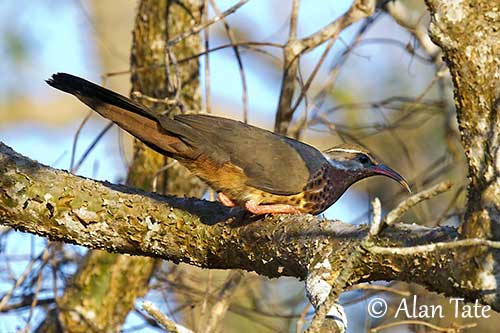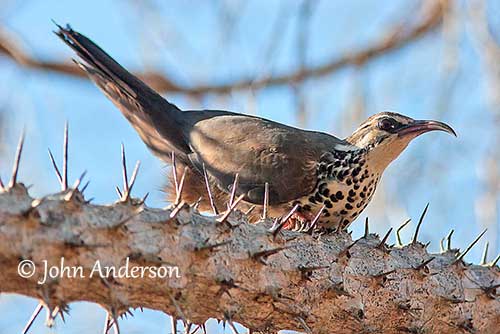
Fr : Mésite monias
Ang : Subdesert Mesite
All : Moniasstelzenralle
Esp : Mesito Monias
Ita : Mesite monias
Nd : Bensch' Monias
Sd : bågnäbbad mesit
Malagasy: Naka
Photographers:
John Anderson
John Anderson Photo Galleries
Jean Michel Fenerole
Photos d’Oiseaux du monde
William Price
PBase-tereksandpiper & Flickr William Price
Alan & Ann Tate
AA Bird Photography
Text by Nicole Bouglouan
Sources:
HANDBOOK OF THE BIRDS OF THE WORLD Vol 3 by Josep del Hoyo-Andrew Elliott-Jordi Sargatal - Lynx Edicions - ISBN : 8487334202
L’ENCYCLOPEDIE MONDIALE DES OISEAUX - Dr Christopher M. Perrins - BORDAS - ISBN: 2040185607
Wikipedia, the free encyclopaedia
Animal Diversity Web (University of Michigan Museum of Zoology)
CREAGUS@Monterey Bay (Don Roberson)
EDGE of Existence - Subdesert Mesite (Monias benschi)
Group living, breeding behaviour and territoriality in the Subdesert Mesite Monias benschi
Subdesert Mesite
Monias benschi
Mesitornithiformes Order – Mesitornithidae Family
INTRODUCTION:
The Subdesert Mesite is one of the three members of the family Mesitornithidae, and the only species of the genus Monias. It is endemic to Madagascar.
The mesites are medium-sized terrestrial birds and they rarely fly. They usually move by walking slowly on the ground. They do not hop, and run only is they are threatened or while chasing a prey. They only perform short flights, mainly up and down, in order to reach their roosting sites. The Subdesert Mesite is the only one that displays sexual dimorphism.
It is threatened by habitat loss through forest clearance, but also by predation by dogs, rats and trappers. This species is currently listed as Vulnerable.

DESCRIPTION OF THE BIRD:
Biometrics:
Length: 32 cm
The Subdesert Mesite adult male has greyish-brown upperparts. The underparts are white, with black crescents on throat, breast and upper belly. Rear flanks and undertail-coverts are brownish.
On the greyish-brown head, there is a long, thin, white stripe above the eye. Cheeks, chin and neck sides are white too.
The fairly long, down-curved bill is red with black tip. The eyes are reddish. Legs and feet are red.
The female has similar upperparts, but she has extensive reddish-brown markings on the white chin, throat and breast. Flanks and undertail-coverts are brown, sometimes with dark spotting on flanks.
On the head, the white areas are mostly buff. She has orange/brown eyes.
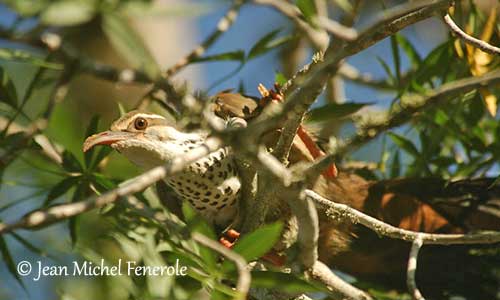
The juvenile is duller than adults. It has dark spotting on breast. The bill is dark grey. Legs and feet are pinkish.
RANGE:
The Subdesert Mesite is endemic to Madagascar where it is found in an area of 200 km long and 70-80 km wide in SW Madagascar, from R Mangoky in N to R Fiheranana in S.
HABITAT:
The Subdesert Mesite is found in dry subdesert thickets and spiny forest growing in sandy soil covered with thick leaf litter. It may tolerate disturbed or degraded habitats, but it usually avoids open areas. It can be seen from sea-level up to 130 metres.
CALLS AND SONGS: SOUNDS BY XENO-CANTO
The Subdesert Mesite sings melodiously in the early morning during the breeding season, and more rarely outside this period. This song consists of strophes of 35-45 seconds long, starting with a loud, rapid series of “zuzuzu zizizizi” followed by a single, sharp, deeper “urrr”. This song is repeated “zuzuzu zizizizi urrr, zuzuzu zizizizi urrr…” and usually, only the sharp, higher notes “zi” can be heard.
This song is probably a duet, with the first individual giving “zu” and “zi” notes, while the second one utters the “urrr” notes. The song varies from pair-duets to choruses by up to 5 birds perched within one metre above the ground.
While foraging in group, they regularly give nasal “chek chek chek”. The alarm call is loud and sharp, or a hissing sound. Vocal communication seems to be very important for these birds.
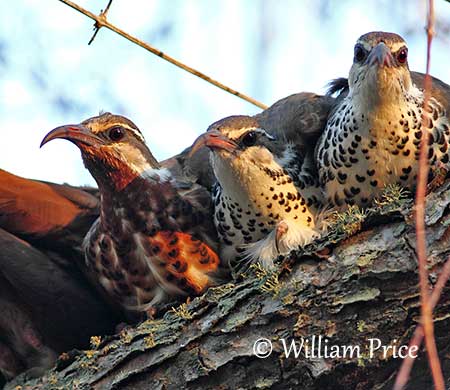
The Subdesert Mesite lives in groups of 2-9 adults, including during the breeding season. The groups defend large, permanent territories and all members take part in defense. The size of the territory is related to the number of males in a group. This species has flexible mating system, and monogamy, polyandry and polygyny may occur.
The Subdesert Mesite performs pair-duets and choruses of up to 5 birds singing together. When two groups meet, they perform a loud singing competition.
From an observation, a kind of ritual display was seen once in November. The males were opponents and jumped high in the air while facing each other, rising up to 30 cm above the ground. There was no contact between them, as they were separated by about 30 cm. During this behaviour, some males and females ran here and there. The chorus of loud, excited “zizi urrr-zizi urrr…” was continuously heard.
The Subdesert Mesite is probably sedentary, and no seasonal movements are reported.
This species was previously described as “apparently unable to fly” but several observations at elevated roost-sites involved an adaptation for flight and arboreal locomotion. If disturbed, the birds take-off and fly over 25-30 metres away before landing. The wingbeats are vigorous and noisy, very similar to those of gamebirds.
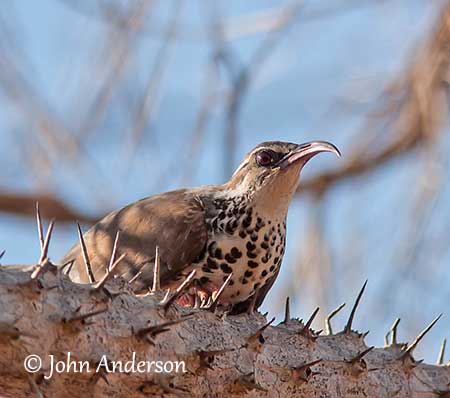
REPRODUCTION OF THIS SPECIES:
The laying occurs mainly between October and April. The nest is a shallow platform of woven twigs with leaves and bark. It is placed in bushes or shrubby-trees, between 60 cm and 2 metres above the ground. The birds reach the nest by climbing up liane tangles.
The female lays 1-2 eggs. Larger clutches are the result of more than one female laying in the same nest. Male and female share the incubation and care for the young. At hatching, the chicks are blackish-brown with pale markings around head and on underparts. The incubation lasts about 21-27 days, and two broods may sometimes be attempted.
PROTECTION / THREATS / STATUS:
The Subdesert Mesite is threatened by habitat loss through clearance of forest for many purposes, and locally by predation (dogs, rats and trappers).
The population is estimated to number 65,000/110,000 mature individuals and is still declining as deforestation continues.
The Subdesert Mesite is currently listed as Vulnerable.
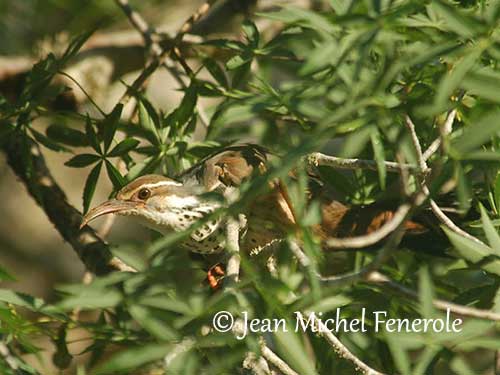
BEHAVIOUR IN THE WILD:
The Subdesert Mesite feeds on insects, seeds and small fruits, depending on the season. It takes invertebrates, adults and larvae, including termites, cockroaches, grasshoppers, caterpillars, beetles and millipedes. It also consumes small amounts of plant matter such as seeds and small fruits.
It feeds by probing and digging below the leaf litter, and pecks on the ground while walking along.
The Subdesert Mesite is terrestrial, except for nesting and roosting. It walks while bobbing the head and flicking its long tail. It retains its bobbing gait when clambering around in tree crowns.
It forms social groups including the pair and their most recent young, and probably others. But the precise intra-group relationships have never been well understood or established.
When threatened, the group scatters in all directions. Then, the birds stand motionless in the shade. They also may fly up onto branches where they lie pressed against each other for long periods.
